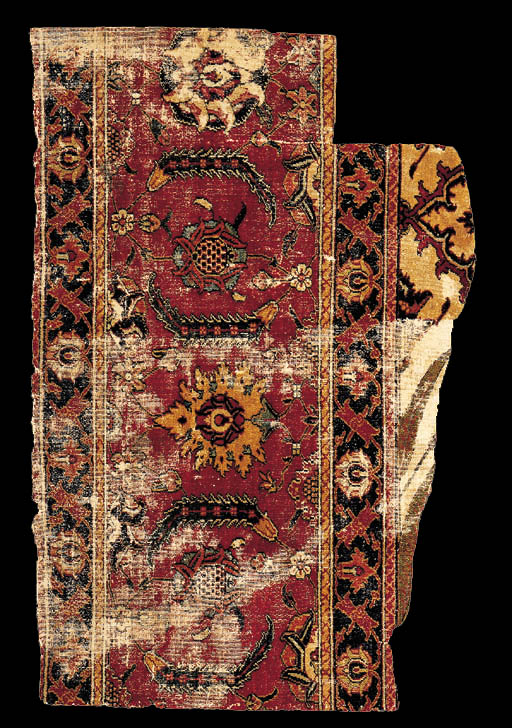|
A KHORASSAN CARPET BORDER FRAGMENT
NORTH EAST PERSIA, 17TH CENTURY
Price Realized £1,880 ($2,698)
Sale Information
Christie's SALE 6435 —
ORIENTAL RUGS AND CARPETS
3 May 2001
London, King Street
LOT NOTES
Lot Description
A KHORASSAN CARPET BORDER FRAGMENT
North East Persia, 17th Century
Comprising a small fragment of the white field with a large-scale lozenge
lattice containing large floral sprays, the burgundy border with alternating
palmettes and flowerheads divided by serrated leaves and linked by angular
vine between indigo angular interlaced arabesque and palmette vine and minor
burgundy and ivory meandering tendril stripes, irregular outline, crease
lines of wear, backed, stretched
2ft.3in. x 3ft.2in. (97cm. X 69cm.)
Exhibited: L'Institut du Monde Arabe, Paris, 1989-1994.
Lot Notes
There is just enough left of the field of this carpet to show that it
comprised a large-scale lattice containing single bold flowers in each
compartment on an ivory ground. The design in its origin is Mughal Indian,
deriving from the red ground Mughal lattice carpets which date from the
second quarter of the 17th century, such as that sold in these Rooms 24
April 1997, lot 425. From a very small number of surviving examples it is
known that this design achieved a certain amount of popularity in Khorassan
in the late 17th century. Some of the examples were woven with a plain red
field like the Indian originals (The Bernheimer Family Collection of
Carpets, Christie's auction catalogue, 14 February 1996, lot 149; Spuhler,
Friedrich: Oriental Carpets in the Museum of Islamic Art, Berlin, London,
1987, no.126, pp.109-110, ill.p.266; and the Satterwhite octagonal carpet
published in Willborg, J.P.: 1980-1990, "Ten Years" Jubilee Exhibition,
Stockholm, 1990, no.1). In others the weavers could not resist having
multicoloured field compartments (Bernheimer Coillection, lot 180; Pope, A.U.:
A Survey of Persian Art, Oxford, 1938, pl.1240). The border of this carpet
is identical in composition to that of the Bernheimer red ground carpet
mentioned above.
In terms of accuracy of drawing and fineness of weave, the carpet from which
this fragment comes was greatly superior to the others of this design. For a
seventeenth century Khorassan weaving it is very fine indeed. It is probable
that this was amongst the first of the copies of Mughal originals and can
therefore be dated to the middle of the seventeenth century. The white
ground may also be a copy of the Mughal; there is a white ground Mughal
lattice fragment in a private collection in London.
 |

